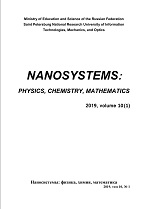|
This article is cited in 4 scientific papers (total in 4 papers)
CHEMISTRY AND MATERIAL SCIENCE
Structure and photoluminescent properties of TiO$_2$:Eu$^{3+}$ nanoparticles synthesized under hydro and solvothermal conditions from different precursors
A. Yu. Zavialovaab, A. N. Bugrovcb, R. Yu. Smyslovcd, D. A. Kirilenkoef, T. V. Khamovag, G. P. Kopitsahg, C. Licitrai, D. Rouchoni
a Saint-Petersburg State Institute of Technology (Technical University), Moskovsky prospect 26, Saint Petersburg, 190013, Russia
b Saint Petersburg Electrotechnical University “LETI”, ul. Professora Popova 5, 197376 Saint Petersburg, Russia
c Institute of macromolecular compounds RAS, Bolshoy pr. 31, 199004 Saint Petersburg, Russia
d Peter the Great Saint Petersburg Polytechnic University, Polytechnicheskaya 29, 195251 Saint Petersburg, Russia
e Ioffe Institute RAS, Politekhnicheskaya ul. 26, 194021 Saint Petersburg, Russia
f ITMO University, 197101, Kronverskii avenue 49, Saint Petersburg, Russia
g Grebenshchikov Institute of Silicate Chemistry RAS, Makarova nab. 2., letter B, 199034 Saint Petersburg, Russia
h Petersburg Nuclear Physics Institute, NRC KI, Orlova roscha mcr. 1, 188300, Gatchina, Leningrad region, Russia
i University Grenoble Alpes, CEA, LETI, F-38000 Grenoble, France
Abstract:
Crystalline phosphors of Eu$^{3+}$-doped titania (TiO$_2$:Eu$^{3+}$) were prepared by hydro and solvothermal synthesis with luminescent ion concentration of 2 mol.%. The structure and shape of the synthesized nanoparticles were characterized using X-ray powder diffraction, transmission electron microscopy, and Raman spectroscopy. Changes in the emission, excitation spectra, and the intensity decay of the photoluminescence for TiO$_2$:Eu$^{3+}$ nanoparticles were analyzed their phase composition. The photoluminescence of synthesized TiO$_2$:Eu$^{3+}$ crystalline phosphors depends on whether the said nanophosphors are formed from organometallic or inorganic precursors under hydro- and solvothermal conditions. Indeed, photoluminescence excitation at wavelengths ranging from 350–550 nm leads to splitting of electron dipole transitions into Stark components according to the symmetry of the Eu$^{3+}$ surroundings. Also, both nanoparticles with the anatase structure and phosphors predominantly containing rutile showed very short photoluminescence lifetimes.
Keywords:
hydrothermal synthesis, titania, europium, solid solution, anatase, rutile, nanophosphors, photoluminescence, fluorescence lifetime.
Received: 18.06.2019
Citation:
A. Yu. Zavialova, A. N. Bugrov, R. Yu. Smyslov, D. A. Kirilenko, T. V. Khamova, G. P. Kopitsa, C. Licitra, D. Rouchon, “Structure and photoluminescent properties of TiO$_2$:Eu$^{3+}$ nanoparticles synthesized under hydro and solvothermal conditions from different precursors”, Nanosystems: Physics, Chemistry, Mathematics, 10:3 (2019), 361–373
Linking options:
https://www.mathnet.ru/eng/nano448 https://www.mathnet.ru/eng/nano/v10/i3/p361
|

| Statistics & downloads: |
| Abstract page: | 111 | | Full-text PDF : | 46 |
|



 Contact us:
Contact us: Terms of Use
Terms of Use
 Registration to the website
Registration to the website Logotypes
Logotypes